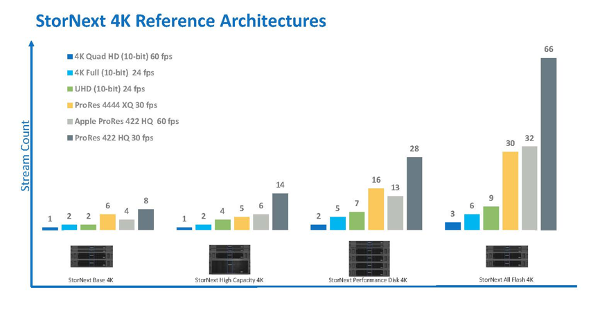Quantum Releases Purpose-Built 4K Video Reference Architectures
 SAN JOSE, Calif. — March 23, 2017 — Quantum Corp. (NYSE: QTM) today announced purpose-built 4K video reference architectures that leverage the company’s StorNext®-powered, disk- and flash-based workflow storage systems to maximize 4K stream counts and optimize performance levels in accordance with users’ specific needs. Based on exhaustive testing with real-world metrics, the new reference architectures reinforce Quantum’s long-standing position as the performance leader in media workflows and empower media facilities to make better-informed investments in 4K storage infrastructure.
SAN JOSE, Calif. — March 23, 2017 — Quantum Corp. (NYSE: QTM) today announced purpose-built 4K video reference architectures that leverage the company’s StorNext®-powered, disk- and flash-based workflow storage systems to maximize 4K stream counts and optimize performance levels in accordance with users’ specific needs. Based on exhaustive testing with real-world metrics, the new reference architectures reinforce Quantum’s long-standing position as the performance leader in media workflows and empower media facilities to make better-informed investments in 4K storage infrastructure.
The Need for Purpose-Built 4K Video Solutions
4K has become the primary driver of storage-purchasing decisions for many media companies, but identifying the best storage medium and system configuration is challenging. Given the wide variety of stream counts and media formats used across different facilities, it’s not necessarily obvious or intuitive what type of storage will deliver the best mix of performance, capacity and cost for a specific workflow or use case. To answer this question, Quantum conducted testing that not only provided a thorough performance characterization but also identified the optimal drive form factors for various media types.
The Role of Flash in Media Workflows
Flash can provide a tremendous amount of performance, and Quantum’s testing showed that flash storage provides excellent value in media workflows where there is a high number of compressed streams — which can leverage the random I/O performance of flash — and where high capacity is not as important. On the other hand, because of the nature of uncompressed formats, flash does not significantly improve performance when there is a high number of uncompressed streams and may be capacity-limiting. StorNext performance optimization applies equally well to flash and disk, thereby giving users the freedom to choose the infrastructure that best fits their performance, capacity and cost requirements.
Maximizing 4K Storage Performance and Value
Quantum’s testing involved 14 different storage configurations using six media formats, all under rigorous, real-world conditions — e.g., arrays filled to 85 percent of capacity and using high-quality RGB data, not the 30-percent-less-demanding YUV data often used by others for evaluation. From this testing, Quantum determined stream counts and performance levels for its StorNext-powered disk drives and arrays, when and where flash is the most cost-effective solution for high performance, higher-resolution workflows, and when a spinning disk configuration can provide better performance for less money — ultimately resulting in the creation of four 4K reference architectures. Based on StorNext-powered Xcellis™ storage systems, these reference architectures are sized for specific stream counts and can scale up as needed to provide additional capacity and performance.
• StorNext Base 4K — Ideal for small workgroups working in compressed formats, supports up to 15 streams of compressed and two streams of full-aperture 10-bit uncompressed 4K.
• StorNext High Capacity 4K — Designed for groups that need additional capacity for primary storage, supports up to 24 streams of compressed and up to six streams of full-aperture 10-bit uncompressed 4K.
• StorNext Performance Disk 4K — The right starting point when higher stream counts and capacity are required, supports up to 28 streams of compressed and up to five streams of full-aperture 10-bit uncompressed 4K.
• StorNext All Flash 4K — Providing maximum compressed stream counts and uncompressed support for high-value content production, supports up to 66 streams of compressed and up to six streams of full-aperture 10-bit uncompressed 4K. This all flash configuration will be on display in Quantum’s booth (#SL5810) at the 2017 NAB Show.


